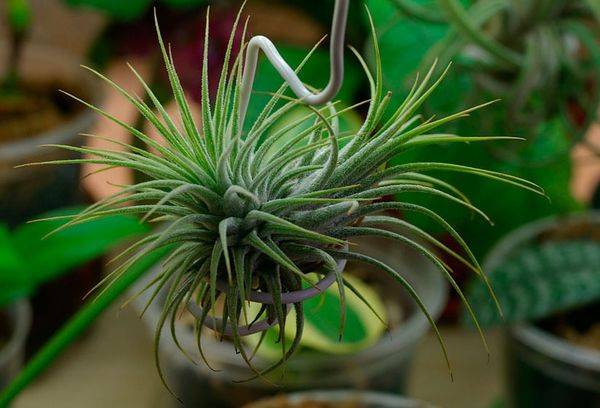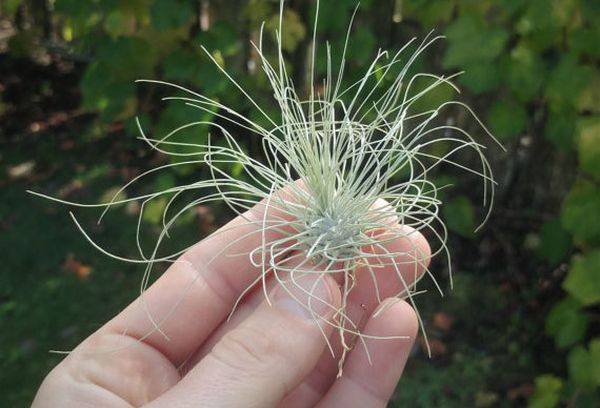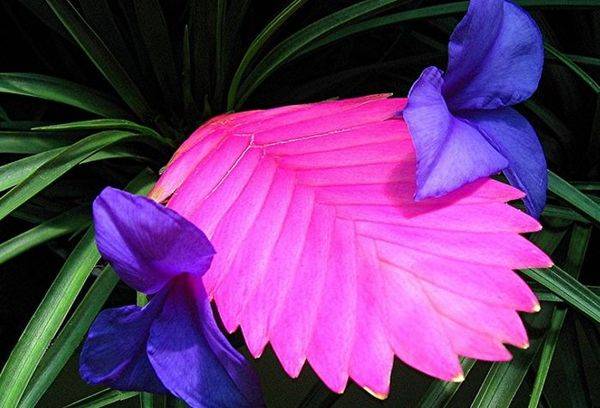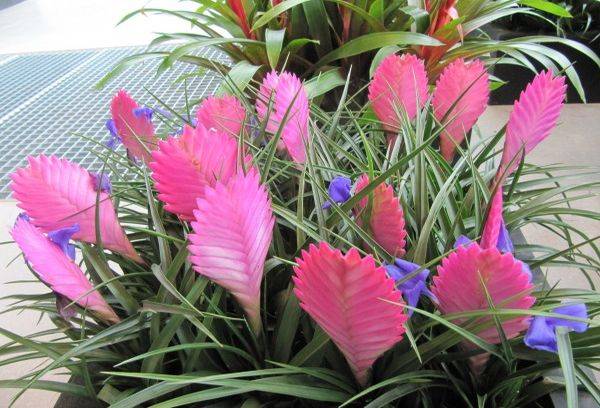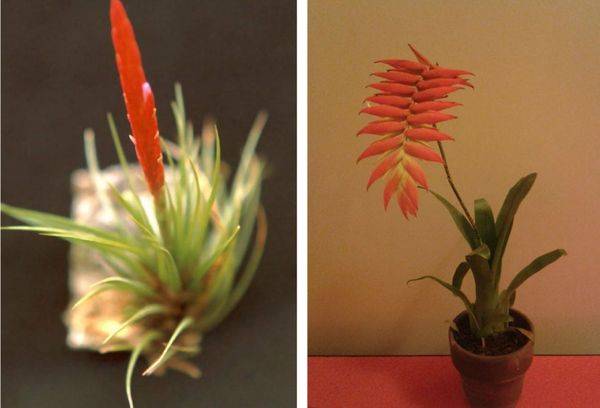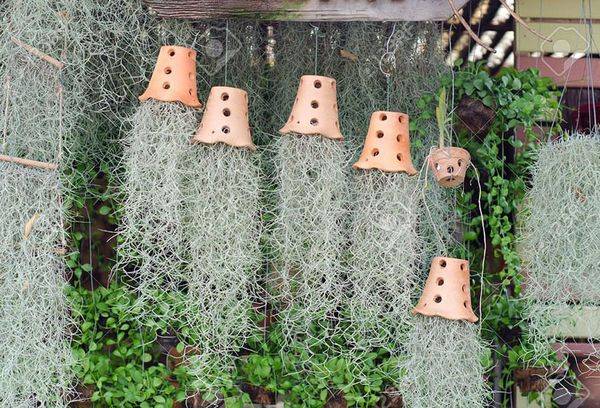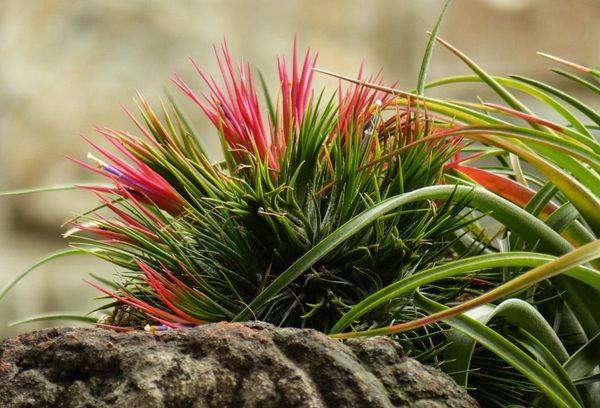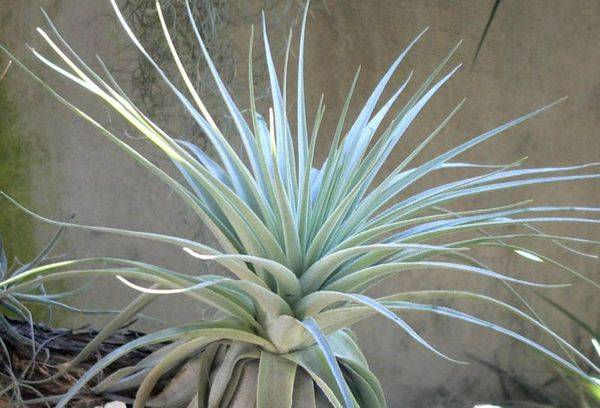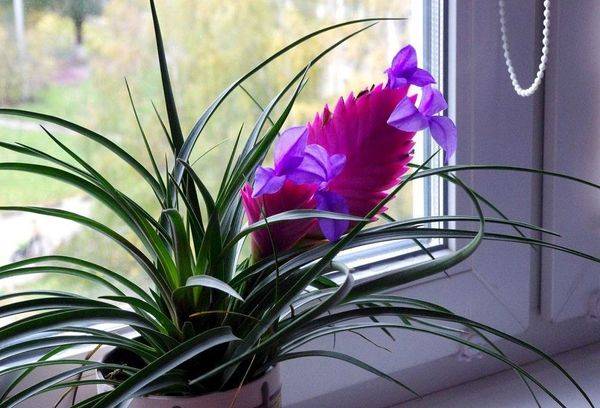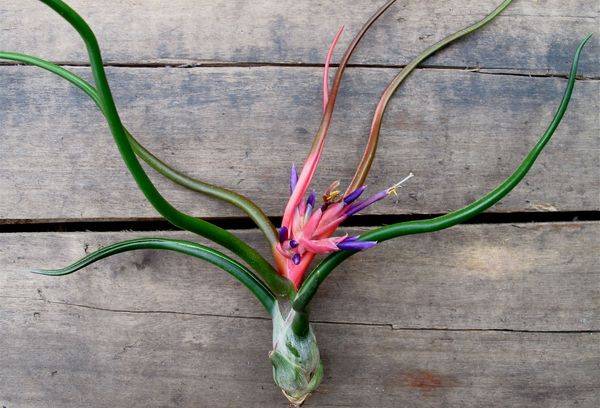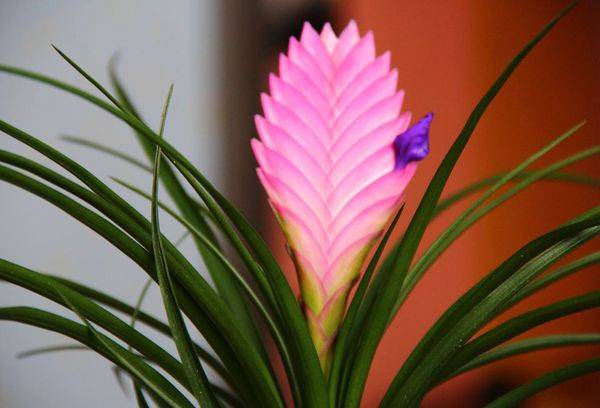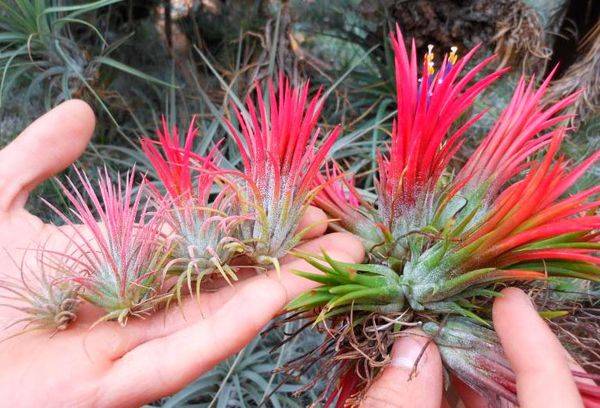How not to get confused about the species and take proper care of Tillandsia
Content:
A striking representative of the Bromeliad family is Tillandsia. Caring for it is not easy, but this does not reduce its popularity. Perhaps the reason is the graceful foliage or spectacular flowering. To understand what Tillandsia is, you need to know that this genus of plants combines two contrasting groups. What else is interesting about tillandsia and how to care for it - read on.
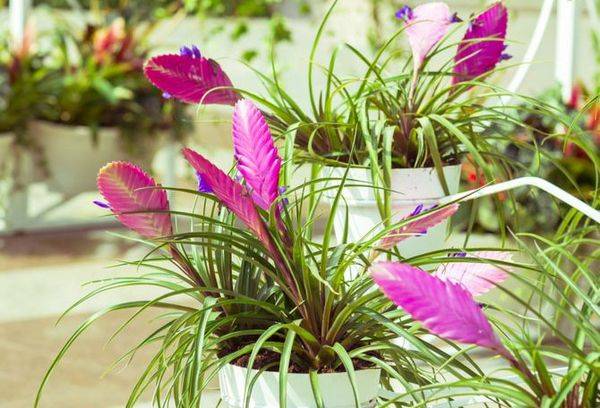
Why is it interesting?
The genus Tillandsia includes two groups of plants. They are not very similar in appearance, but differ even more in preferences. If representatives of the first group are familiar to the average gardener, then plants of the second group are rare, mainly in the private collections of professional gardeners. So, two types of tillandsia:
- Potted tillandsias, or green ones. They take root well at home and prefer regular soil. They are attractive for their flowering: the luxurious rosette of leaves seems to smooth out the “prickliness” of the inflorescences.
- Tillandsia epiphytes, or silvery (gray). These capricious representatives of the genus are characterized by luxurious foliage, against which the flowering is not so attractive. Epiphytes are rare because they are very demanding and do not take root well in indoor conditions. Such tillandsias have another name - atmospheric.
The color of the foliage is the first distinguishing feature by which tillandsia belongs to a particular group. Therefore, among flower growers there are names of tillandsias based on color: gray or green. This is not the most accurate definition for a plant. Among potted tillandsias there are hybrids with a gray color of the vegetative mass. Despite the differences, potted and epiphytic tillandsias are combined into one genus. Hundreds of species of the genus Tillandsia grow in North and South America.
Just as the types of tillandsia are diverse, their habitats are amazing. The plant is found in tropical forests and arid savannas. It grows equally successfully both on mountain slopes, whose soils are infertile, and in semi-deserts, where air humidity leaves much to be desired. Epiphytic plants settle on trees, potted plants prefer the reliability of the soil.
Varieties
Green or potted tillandsias are more similar to other representatives of bromeliads. These are small evergreen plants with a rosette of narrow long leaves, pointed towards the end. The rosette is very dense, which makes it stand out from the background of neighboring plants. Every year the mother rosette dies off and is replaced by a daughter rosette. A peduncle grows from the center. The inflorescence on it has an unusual shape, reminiscent of an ear or a feather. The beauty of the flower lies in the bright bracts: their color is pure and rich.
Types of green tillandsias:
- Blue Tillandsia (Tillandsia cyanea) - the most popular plant among tillandsias for home growing. The bush reaches a height of 25 cm, that is, it is not large. The leaves are green, covered with small scales, have a red-brown tint at the base, and are covered with brown stripes along the entire length.The bracts are usually pink or purple. Blue, purple or light blue flowers form along the edges. There are very few of them (one or two), and they quickly fade.
- Tillandsia Anita - a hybrid obtained using blue tillandsia. If you are shown a photo of Tillandsia, then most likely it is this species. It has a dense rosette of leaves, short flower stalks, pink or purple bracts and pretty blue flowers.
- Tillandsia dyeriana - another popular representative of potted tillandsias. It has an inflorescence in the form of a loose spikelet. The color of the bract is reddish-orange.
The trump card of epiphytic tillandsias is not in the inflorescences, but in the foliage. Thin and almost transparent leaves, together with fragile stems (if present), form an elegant green-gray cloud. Interestingly, the leaves perform not only their main function, but also the function of the roots: through them the plant receives moisture and feeds. This happens thanks to the scales that cover the leaf. Because of them, the foliage appears gray. The root system is practically absent and serves for anchorage.
Types of epiphytic tillandsias:
- Tillandsia usneoides - leader in popularity among atmospheric ones. Because of its appearance it is called "angel hair". It has narrow thread-like leaves covered with scales. Hanging down, they form a beautiful cascade. The plant looks best on a support.
- Tillandsia ionantha. Rosettes are formed by silvery curved leaves. By mid-summer it produces a blue-violet inflorescence similar to a spike.
- Silver Tillandsia (Tillandsia argentea) - the owner of thin leaf plates that extend from the base in a chaotic manner.
Care
Plants of different groups differ not only in appearance, but also in their maintenance requirements. Tillandsia care begins with the correct placement of the pot with the young seedling. For potted species, window sills on the west or east side are suitable. This plant needs a bright place, but without direct sunlight. With slight shading, it is possible to grow tillandsia on a south window, while blue tillandsia easily gets along on the north side. As for atmospheric varieties, they prefer shade.
Air humidity requirements:
- for green species, a tray filled with moss is sufficient;
- for gray ones, it is necessary to maintain high air humidity (60-70%). It is better to place the plant in a florarium.
Potted species require frequent watering. The soil should not dry out. In summer, water is poured into the soil and into the sockets. Tillandsia needs to be sprayed regularly.
Advice
Use soft and warm water for both watering and spraying.
With the onset of winter, watering is reduced, allowing the soil to dry out a little. Atmospheric species do not need watering; they receive all the necessary moisture directly from the air. Therefore, you just need to spray them and the space around them as often as possible. The magazine purity-en.htgetrid.com recommends spraying atmospheric tillandsias daily if the room temperature exceeds +15⁰ C.
The optimal temperature for growing any species in summer will be +20-28⁰. If possible, take the flowerpots out into the fresh air, for example, onto a balcony. In winter, make sure that the room temperature does not fall below +18. In winter, potted species need to extend daylight hours with a lamp.
Fertilizers will not be superfluous.Choose complex mineral fertilizers for orchids or beautiful flowering plants, only the concentration must be reduced by two or even four times. The composition must contain a minimum amount of copper, since this substance is toxic to all representatives of the Bromeliad family. Fertilizers are applied once every two weeks. Feeding time is summer. It is better to apply fertilizer by foliar method, by spraying; it is not recommended to fertilize the soil. Although fertilizing stimulates the growth of tillandsia, it is not vital.
Transfer
Atmospheric samples do not require changing the pot and soil. Green tillandsias need to be replanted once every 2-3 years. A sign that it is time to “move” are roots sticking out of the drainage holes. It is better to replant an overgrown bush.
The growing container should not be deep, since the root processes of tillandsia are mainly superficial. It is better to choose a moderately wide flowerpot. To grow tillandsias, it is recommended to use orchid or bromeliad soil. The main characteristics of the substrate: it must be loose, water- and breathable, and light. How to prepare soil for tillandsia yourself:
- leaf soil - 1 part;
- sphagnum moss (chopped) - 1 part;
- peat - 1 part;
A little crushed charcoal, chopped sphagnum moss or fern roots will not hurt in the soil. In the first week after transplantation, watering should be avoided.
Important
Transplantation is carried out strictly after flowering - wait until the mother rosette is replaced by a young daughter rosette.
Reproduction
Tillandsia can be propagated in three ways:
- seeds,
- children,
- lateral processes.
The seed propagation method is not the most popular, since the young plant takes a long time to develop. If you still want to try, then stock up on sand and peat substrate and patience. The seeds are distributed over the surface of the soil, moistened and covered with polyethylene. For the seeds to germinate, place the pots in a warm (at least +25⁰ C) and well-lit place. The first shoots appear a month later.
When propagating vegetatively, wait until the young shoot reaches half the size of the main plant (on average, about 10 cm), and then separate it. The best time to transplant is spring and summer. Layers are planted in a mixture of peat and sand (taken in equal proportions). Rooting lasts about 2-3 months. When the young plant gets stronger, it needs to be transplanted into soil for adult plants.
Bloom
If tillandsia was grown from seed, then it is expected to bloom only in the fifth year. Propagated vegetatively produces flowers in the second year. Typically, the flowering period occurs in the summer, but under certain conditions it is possible to observe the play of colors in the fall and even in winter. Flowering duration is two months.
The peduncle appears first. Flowers then form. Basically, they only complement the beauty of the peduncle. As flowers die, they need to be removed. The same is done with dried leaves.
Advice
To make your tillandsia bloom, spray it with zircon solution once a week.
Growing problems
Most often, the plant is affected by the bromeliad scale insect, a parasite that leaves brown spots on the back of the leaf. The pest is removed from the flower manually. Then the affected plant is treated with a soap solution. As a last resort, spraying with insecticides is used.
If the leaves lose their rich color and become covered with gray and brown spots, then the tillandsia is affected by a fungus. Infected parts of the plant must be removed, and the remaining shoots must be treated with a fungicide. Fungal infection occurs due to improper care: waterlogging or drying out of the soil, lack of light, heat, and drafts. It is better to properly care for tillandsia from the first days of its purchase than to treat the consequences of inattention.
Interesting to know
After your guests stop admiring the beauty of tillandsia, surprise them by telling them these facts about the plant:
- The flower was first described by the 17th century Swedish botanist E. Tillands, after whom it was named.
- The plant evoked many associations, for which people gave it the names “old man’s beard”, “Spanish moss” and even “angel hair”.
- Birds use parts of the plant to build nests.
- Epiphyte and parasite are not the same thing. Although both species are attached to another plant, the epiphyte does not receive nutrients from its support.
- The thread-like leaves were at one time dried and used to stuff mattresses and pillows.
- Various compositions are created from epiphytic plants to decorate the interior. This flower can be hung almost anywhere. Various stands made of clay, stone and even pieces of bark are used for mounting.
The effort put into growing this beautiful Tillandsia is well worth it. It is not for nothing that the plant has acquired a reputation as the most exotic of exotics. A gardener who grows tillandsia, especially the atmospheric type, deserves applause. And the best reward is unique flowering.
